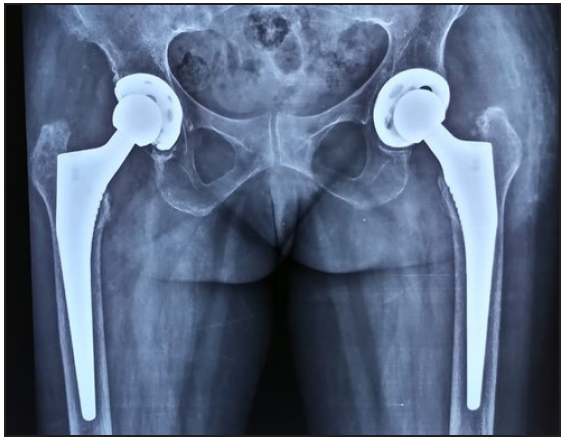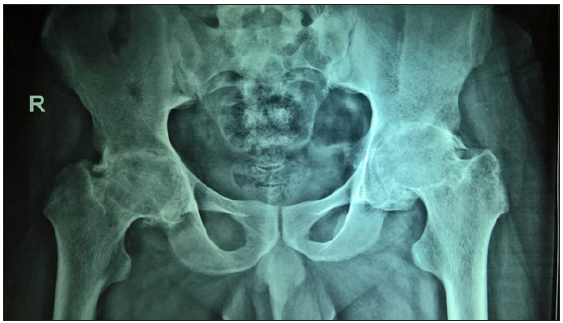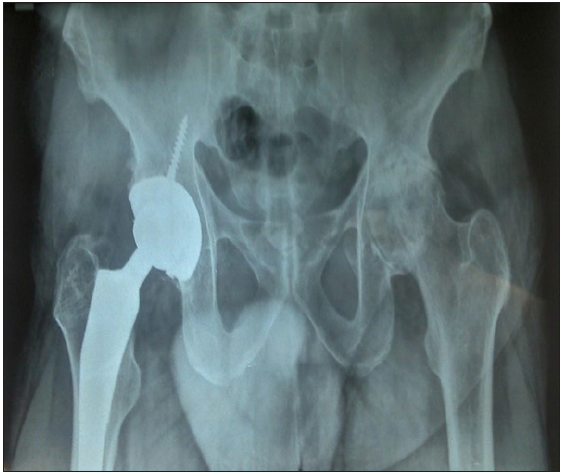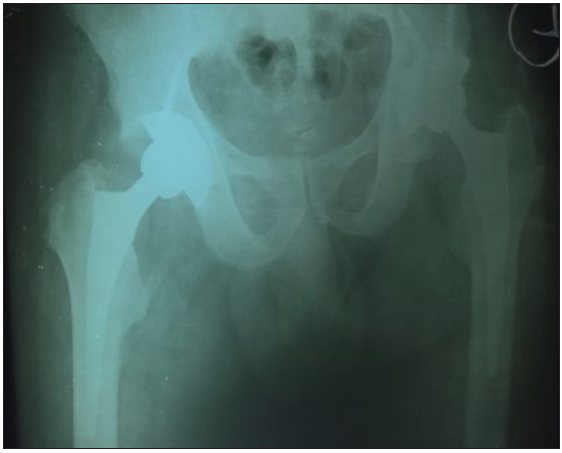Translate this page into:
Comparative Study of Pre-operative, Operative, and Post-operative Parameters of Single and Staged Bilateral Total Hip Replacement

Corresponding author: Dr. Monalisa Mohapatro, Department of Biochemistry, Sriram Chandra Bhanja Medical College, Cuttack, India. monalisa.mohapatro@gmail.com
-
Received: ,
Accepted: ,
How to cite this article: Mohapatro M, Panigrahy B, Behera SK, Hota SK. Comparative Study of Pre-operative, Operative, and Post-operative Parameters of Single and Staged Bilateral Total Hip Replacement. Int J Recent Surg Med Sci. 2024;10:35-41. doi: 10.25259/IJRSMS_45_2023
Abstract
Objectives
Total Hip replacement (THR) is now emerging as the most successful surgery that can drastically improve the quality of life of an arthritis patient. Bilateral (B/L) hip involvement is seen in many cases where there is a treatment option of operation on both hips in a single operation under single anesthesia or a staged operation. The present study aims to compare the pre-operative, operative, and post-operative parameters of single operation Bilateral Total Hip Replacement (B/L THR) and staged B/L THR (two operations in stages; second operation done after 6–7 days).
Material and Methods
97 B/L THR cases were included in a retrospective cohort study operated Delete conducted 2017–2021 under a single surgeon in a tertiary care hospital. The age, sex, and Body Mass Index (BMI) - matched cases were divided into Group 1-single B/L THR and Group 2-staged B/L THR. The patients were assessed on blood loss during surgery and post-surgery up to 24 h, time to reach visual pain analog score of baseline 3, pre and post-operative Harris Hip score, post-operative hemoglobin (Hb) level, infection, dislocation, deep vein thrombosis and duration of hospital stay.
Results
Thirty-seven cases of Group 1 Single B/L THR and 60 cases of Group 2-Staged B/L THR were analyzed. The time taken for pain to decrease was more in Single B/L THR which was statistically significant. Even though the intra-operative and post operative blood loss was not statistically significant, still more number of cases showed greater blood loss in Staged B/L THR. The pre-operative and post-operative hip functionality outcome was statistically same in both groups. Complications like deep vein thrombosis (DVT) showed lower incidence in Single B/L THR; and equal incidence of infection in both groups. The duration of hospital stay was more in Staged B/L THR. The statistical significance of longer duration of pain in Staged B/L THR can be explained on basis of two injuries inflicted by two operations 6–7 days apart. Harris Hip score for assessing hip functionality did not show statistical significance indicating that both single and staged show similar improvement of hip function. Lower incidence of DVT in Staged B/L THR can be attributed to early mobilization and physiotherapy.
Conclusion
On the basis of the above study, we conclude that Single B/L THR is feasible, safe and cost-effective with similar functional outcomes and early return to the society. Therefore, it should be encouraged in tertiary care hospitals.
Keywords
Single B/L THR
Staged B/L THR
Harris Hip score
DVT
INTRODUCTION
Total hip replacement (THR) is one of the most successful and sought-after surgeries that can drastically change the quality of life of an arthritis patient. Patients generally have bilateral (B/L) hip involvement in cases like avascular necrosis (AVN) of the head of the femur that is one of the significant causes of developmental dysplasia, ankylosing spondylitis, and rheumatoid arthritis.[1]
B/L hip arthritis can be operated in single or staged operation (i.e., two operations within a gap of few days). In 1971, Charnley first demonstrated the feasibility of simultaneous bilateral (B/L) THR.[2] Operating bilaterally in a single operation theoretically has the advantage of single anesthesia, more rewarding to the surgeon, single rehabilitation program, more patient satisfaction, few hospital stays, and reduced cost. However, it may have disadvantages like increased surgical risk and higher incidence of post-operative complications like thromboembolic episodes. Studies conducted comparing unilateral to single B/L and staged B/L are of the view that in single Bilateral Total Hip Replacement (B/L THR), mortality and with mortality, and complications were similar to unilateral THR and even allowed better control of limb length;[3] whereas other studies show concern about post-operative complications and increased risk with higher transfusion rate.[4] Aghayev et al. have demonstrated that the possible intra and post-operative complications of single simultaneous B/L THR are equal to staged THR,[5] whereas Berend et al. showed a higher rate of in-patient complications with increased blood transfusion and failure to reach physical therapy goals in single B/L THR.[6] Hence, the choice of operation remains controversial. In the pursuit of finding an appropriate approach, comparative studies on B/L THR single or staged have been conducted, but they mainly comprise THR done on one side and then on the other after a few days or in a different set-up. Comparative data of B/L THR single and staged operation done in a single institution under a single surgeon is limited.
The aim of our study is to analyze the pre-operative, operative and post-operative parameters of bilateral operations done in a single and staged operation procedure in the same admission after a days gap of 6–7 days, and compare which is more suitable for the Indian setup.
MATERIAL AND METHODS
A retrospective cohort study was done for all the cases of B/L THR operated between 2017 and 2021 under a single surgeon in a tertiary care hospital. This study was approved by the Institutional Ethical Committee: IEC no. 797/Chairman-IEC, MKCG Medical College, Brahmapur-4.
Inclusion criteria
Ninety-seven cases of B/L hip involvement due to AVN (idiopathic, steroid-induced, sickling) and inflammatory arthritis operated under a single surgeon in single admission were included in this study. The age and sex matched patients were grouped into two groups – Group 1 comprising of patients operated in a single operation (Single B/L THR) that consisted of 37 cases and Group 2 comprised of patients operated in two operations in the same admission in span of 6–7 days ( Staged B/L THR) which consisted of 60 cases.
Exclusion criteria
The following criteria were considered for excluding patients from our study: Patients with comorbid conditions or significant medical complications (cardiovascular and respiratory) requiring intensive care unit (ICU). Cases operated for other procedures apart from THR, and Patients with known coagulopathy and B/L THR done in different stages. The cases lost to follow-up (3 cases of single B/L THR and five cases of staged B/L THR) were also excluded from our study.
Pre-operative evaluation
A detailed history was taken; routine investigations and pre-operative hemoglobin (Hb) were estimated. Initial radiographs were done, and hip functionality was assessed by Harris Hip Score (HHS), a measure of dysfunction.[7] It is divided into three sections: section 1 are questions answered by the patient about pain and its impact like using support devices, maximum distance walked, limp, ability to put on shoes and socks, ability to use stairs, ability to enter public transportation, ability to sit; section 2 and section 3 are clinical assessment of hip joint i.e. absence of deformity (less than 30 degrees fixed flexion contracture, less than 10 degrees fixed abduction, less than 10 degrees fixed internal rotation in extension, limb length discrepancy less than 3.2 cm); and function i.e. total degrees of flexion, abduction, external rotation, adduction). Results were interpreted as <70 - poor result, 70–80 - fair, 80–90 – good, and 90–100 - excellent. Informed written consent was taken from all patients.
Surgical method
All patients were operated on through a mini-invasive postero-lateral incision under a spinal block in a lateral position.[8] The leg was positioned loosely in 30° hip flexion and 60° knee flexion. Sterile draping was applied. A line is drawn on the skin from the lateral femoral condyle to the tip of the greater trochanter, the middle of this line being the new landmark, and then joined proximally to the posterior superior iliac spine. On this line, a perpendicular was drawn to the axis of the femur from the tip of the trochanter, and the skin incision of 6–8 cm long was made along the oblique posterior iliac line 3–4 cm proximally and 3–4 cm distally to this point. The gluteus maximus muscle is divided, and underlying structures reached with the use of self-retaining retractor. Thus, the posterior part of the neck is reached through short external rotators, with the hip in internal rotation. The neck is cut, the head is delivered, then acetabular preparation is done, followed by femoral preparation; a trial implant was tried. Arthroplasty is completed with non-cemented acetabular and femoral components. The capsule with rotators was repaired back to the trochanter. The wound is closed over a drain.
In single B/L THR, an operation was done on both hips under single anesthesia [Figures 1a, 1b]. In staged B/L THR operation, the second operation was done in the same hospital admission in a similar manner after a span of 6–7 days, when the patient was found fit for surgery after stabilization of routine parameters [Figures 2a, 2b, 2c].

- Pre-operative X-ray (R-right side) of patient of Single B/L THR; B/L THR: Bilateral Total Hip Replacement.

- Post-operative X-ray of Single B/L THR; B/L THR: Bilateral Total Hip Replacement (B/L THR).

- Pre-operative X-ray (R-right side) of Staged B/L THR; B/L THR: Bilateral Total Hip Replacement.

- Post-operative X-ray of Staged B/L THR operated on one side; B/L THR: Bilateral Total Hip Replacement.

- Post-operative X-ray of Staged B/L THR operated on other side; B/L THR: Bilateral Total Hip Replacement (B/L THR).
Post-operative care
Post-operatively, patients were kept on analgesics, and epidural top-up continued for 24–48 hrs. Patients were made to stand on the second day and encouraged to walk if tolerated; otherwise, walking was started on the third day. The drain was removed after 48 hours. Patients were kept on antibiotics for three days. Pain was assessed by the Visual Pain analog scale each day until a baseline of 3 was achieved.[9] Routine blood parameters and Hb levels were assessed. The hip score was again assessed on discharge. All patients were kept on oral anticoagulant Rivaroxaban for two weeks post-operatively. Patients who complained of calf pain and swelling in the leg were evaluated for DVT.[10] Though a venogram is the gold standard for diagnosing DVT, it is invasive and less preferred in our scenario; hence, conformation was done by Doppler study of lower limbs, which was recorded and treated accordingly. Any other post-operative complications like infection or dislocation were also dealt with. Patients in both groups followed a similar conservative rehabilitation protocol postoperatively that included avoiding cross-legging in their daily activities. Hip functionality was assessed by Harris Hip Score after three months of surgery in Single B/L THR and after three months of second surgery in Staged B/L THR. Patients were followed for two years post-discharge from the hospital.
Statistical analysis
Data analysis was done by independent t-test using Statistical Package for the Social Sciences (SPSS) 20 software and Microsoft Excel sheet. Data was represented as Mean ± SD. A p-value <0.05 was considered significant.
RESULTS
The present study included 97 cases of B/L THR operated in single (37 cases) or staged (60 cases) operation in a single hospital admission. The patients were assessed based on pre-operative, operative, and post-operative parameters.
Pre-operative parameters
The pre-operative Hb level was almost similar in both groups, i.e., 10.5 ± 0.33 gm% in Group 1 Single B/L THR and 10.6 ± 0.35 gm% in Group 2 Staged B/L THR that was found to be statistically insignificant. The pre-operative Hip Score was also similar in both groups: 51.5108 ± 6.23759 in Group 1 Single B/L THR and 50.9550 ± 6.37199 in Group 2 Staged B/L THR that was found to be statistically not significant [Table 1].
| Parameter | Group 1: Single B/L THR | Group 2: Staged B/L THR | p-value | |
|---|---|---|---|---|
| 1. | Number of cases | 37 | 60 | |
| 2. | Age in years | 46.67 ± 5.6 | 48.72 ± 6.603 | Not Significant |
| 3. | Male:Female | 20 males:17 females | 44 males:26 females | |
| 4. | Pre-operative Hip score | 51.5108 ± 6.23759 | 50.9550 ± 6.37199 | Not significant (0.675) |
| 5. | Pre-operative Hb level in gm% | 10.5 ± 0.33 | 10.6 ± 0.35 | Not significant |
B/L THR: Bilateral Total Hip replacement
Operative parameters
Comparing the blood loss during surgery, <50 ml was seen in 07 (18.9%) of Group 1 Single B/L THR and 17 (28.3%) of Group 2 Staged B/L THR. 50–100 ml of blood loss was seen in 21 (56.75%) of Group 1 Single B/L THR and 7 (11.6%) in Group 2 Staged B/L THR. >100 ml blood loss was seen in 9 (24.3%) of Group 1 Single B/L THR and 36 (60%) in Group 2 Staged B/L THR [Table 2].
| Parameter | Group 1: Single B/L THR no of cases = 37 | Group 2: Staged B/L THR no of cases = 60 |
|---|---|---|
| 1. Blood loss during surgery | ||
| <50 ml | 07 (18.9%) | 17 (28.3%) |
| 50–100 ml | 21 (56.75%) | 07 (11.6%) |
| >100 ml | 09 (24.3%) | 36 (60%) |
Bold value: 56.75% in Group 1 indicates that blood loss during surgery is higher in comparison to Group 2; Bold value: 60% in Group 2 indicates that blood loss during surgery is higher in comparison to Group 1; B/L THR: Bilateral Total Hip Replacement
Post-operative parameters
The time taken to reach the Visual pain analog score (VAS) of baseline 3 in days was found to be 5.92 ± 0.493 in Group 1 Single B/L THR as compared to 10.50 ± 0.701 in Group 2 Staged B/L THR that was found to be statistically significant. (p = 0.000)
The post-operative blood loss as seen in both groups was <300 ml seen in 06 (16.21%) of Group 1 Single B/L THR and 15 (25%) of Group 2 Staged B/L THR; 300–500 ml of blood loss was seen in 22 (59.45%) of Group 1 Single B/L THR and 07 (11.66%) in Group 2 Staged B/L THR and >500 ml blood loss was seen in 09 (24.32%) of Group 1 Single B/L THR and 38 (63.33%) in Group 2 Staged B/L THR.
The post-operative Hb level was estimated as 9.319 ± 1.3668 gm% in Group 1 Single B/L THR with 06 (13.2%) cases <8 gm% and 31(83.8%) cases >8 gm% as compared to 8.692 ± 1.1885 gm% in Group 2 Staged B/L THR with 22 (36.67%) cases <8 gm% and 38 (63.33%) cases >8 gm% that was found to be statistically significant. (p = 0.019)
Deep vein thrombosis was seen in 1 Group, 1 Single B/L THR, compared to 3 Group 2 Staged B/L THR cases.
Infection was seen equally (1 case) in Groups 1 and 2 B/L THR. Clinically, there was discharge from the surgical site that was serosanguinous in nature. It healed with the usual course of antibiotics.
Dislocation was not observed in both groups.
The post-operative Hip score was 90.7784 ± 5.35743 in Group 1 Single B/L THR and 90.6367 ± 4.60881 in Group 2 Staged B/L THR, which was statistically insignificant. (p = 0.890) Comparing the categories, <70 Poor was not seen in both groups, 70–80 Fair was seen in 2 (5.4%) in Group 1 Single B/L THR and 3 (5%) in Group 2 Staged B/L THR. 80–90 Good was seen in 14 (37.8%) Group 1 Single B/L THR and 29 (48.3%) Group 2 Staged B/L THR. 90–100 Excellent in 21 (56.7%) in Group 1 Single B/L THR and 28 (46.6%) in Group 2 Staged B/L THR.
The duration of hospital stay in days was 5.32 ± 0.747 in Group 1 Single B/L THR and 9.32 ± 0.701 in Group 2 Staged B/L THR, which was statistically significant (p = 0.000) [Table 3].
| Parameter | Group 1: single B/L THR N = 37 | Group 2: staged B/L THR N = 60 | p-value |
|---|---|---|---|
| 1. Time taken to reach Visual pain analog score of baseline 3 in days | 5.92 ± 0.493 | 10.50 ± 0.701 | Significant (0.000) |
| 2. Blood loss post-operatively | |||
| <300 ml | 06 (16.21%) | 15 (25%) | |
| 300–500 ml | 22 (59.45%) | 07 (11.66%) | |
| >500 ml | 09 (24.32%) | 38 (63.33%) | |
| 3. Post operative Hb level in gm% | 9.319 ± 1.3668 | 8.692 ± 1.1885 | Significant (0.019) |
| < 8 gm% | 06 (13.2%) | 22 (36.67%) | |
| >8 gm% | 31 (83.8%) | 38 (63.33%) | |
| 4. DVT | 01 cases | 03 cases | |
| 5. Infection | 02 cases | 02 cases | |
| 6. Dislocation | - | - | |
| 7. Post operative Hip score | 90.7784 ± 5.35743 | 90.6367 ± 4.60881 | Not significant (0.890) |
| < 70 Poor | - | - | |
| 70–80 Fair | 02 (5.4%) | 03 (5%) | |
| 80–90 Good | 14 (37.8%) | 29 (48.3%) | |
| 90–100 Excellent | 21 (56.7%) | 28 (46.6%) | |
| 8. Duration of hospital stay in days | 5.32 ± 0.747 | 9.32 ± 0.701 | Significant (0.000) |
Bold value: 59.45% in Group 1 indicates that blood loss post-operatively is significantly higher in comparison to Group 2; Bold value: 63.33% in Group 2 indicates that blood loss post-operatively is significantly higher in comparison to Group 1; Bold value: 36.67% in Group 2 indicates that Hb level is significantly higher in comparison to Group 1; B/L THR: Bilateral total Hip Replacement; Hb: Hemoglobin: DVT: Deep Vein Thrombosis
DISCUSSION
THR is one of the most satisfying and successful remedies for the arthritis of the hip and its sequelae. The number of patients in India opting for replacement in general and THR in particular is now rising. This is because of the introduction of various schemes and insurance packages, due to which even the poorest of poor patients who earlier were reluctant or could not afford, now opt for this procedure. Patients come from remote places seeking surgery; hence, early management and disposal of these cases remain an objective. Many cases present bilateral involvement, which can be operated in a single or staged operation. With the number of cases of THR increasing, the feasibility of single-stage THR remains a non-practicable thought because of the risk of complications.[11] Earlier studies on single and staged THR have analyzed results on parameters like a hospital stay, cost, and blood loss; thromboembolic events like DVT and pulmonary embolism, dislocations, sciatic nerve palsy, trochanteric fracture, hematoma, wound infection, etc.; and have published opposite extremes of results. Staged B/L THR done in two sessions increases cumulative surgery time increasing in anesthesia time that also increases the risk of infection, venous thromboembolism, neurologic deficit, revision, intra-operative blood loss, transfusion, and other adverse effects. However, there is scanty literature on data obtained from single institutions and single admission THR surgeries. Hence, our study comparing B/L single THR and staged THR (same admission) compared complications like intra-operative and post-operative blood loss, pre and post-operative Hb%, pain (reaching baseline 3 on VAS), Harris Hip score, infection, DVT, dislocation and duration of hospital stay was undertaken. Patients with comorbid conditions or major systemic complications like cardiovascular failure, pulmonary failure, or stroke requiring an extended hospital stay and Intensive Care Unit setup were not included in our present study.
In our study, age, sex, and BMI-matched patients were grouped as per the operation procedure, i.e., single B/L THR and Staged B/L THR. The pre-operative Harris Hip Score and Hb level were equal in both groups and statistically insignificant.
In comparison to the intra-operative parameters, the blood loss during surgery was measured from markings on the suction canister. We affirm the readings as we did not use diluents like normal saline. The results from both groups were not statistically significant in our study. However, in Single THR, 21 cases (56.75%) showed blood loss of 50–100 ml, whereas in Staged B/L THR, 36 cases (60%) showed >100 ml blood loss. As 90% of blood loss occurs between skin closure and the first post-operative 24 hours[12] the post-operative blood loss was estimated in both cases. This was found to be statistically not significant in our study; however, 22 cases (59.45%) showed blood loss of 300–500 ml in Single B/L THR, whereas 38 cases (63.33%) had >500 ml blood loss in staged B/L THR. These findings are similar to studies done by Bhan S et al.[10] and Salvati EA et al.[13] and a systemic review and meta-analysis done by Ramezani A et al.[14], which showed that single B/L THR had lower blood loss. However, some studies like Berend et al.[15] have proposed an increased requirement for blood transfusion after Single B/L THR.
The pain gradually decreased postoperatively during the hospital stay but aggravated with mobilization and physiotherapy. The pain was assessed as the number of days reaching baseline 3 on the visual pain analog score.[16] Pain was found to be 5.92 ± 0.493 days in Single B/L THR and 10.50 ± 0.701 days in Staged B/L THR, which was statistically significant. This increase in number of days in Staged B/L THR can be explained on the basis of the injury being inflicted by two different surgeries on two different occasions in Staged B/L THR compared to a single surgery in Single B/L THR.
On comparing the post-operative DVT, 1 (one) case of Single B/L THR and three cases of Staged B/L THR were observed. Lower hospital stay, early mobilization, early initiation, and better compliance to weight-bearing and physiotherapy in Single B/L THR resulted in a lower incidence of DVT than in Staged B/L THR. This is a consistent study done by Ramezani et al.[14] that showed decreased risk of DVT in Single B/L THR. However, a study done by Bhan et al.[10] found a similar incidence of DVT in both groups. Despite pulmonary embolism being a common complication in THR,[17] we have not encountered it in our study which can be attributed to anticoagulation therapy and early post-operative mobilization in both groups.
Another complication found in our study is infection in one case of both Single B/L THR and Staged B/L THR. The infection was superficial, with an indurated skin margin with normal baseline hematological parameters. The infection healed without any further intervention at the time of stitch removal.
There were no dislocations reported in our study that may be attributed to meticulous posterior structure (i.e. posterior capsule and short rotators) repair intra-operatively.
To assess hip functionality, the Harris Hip score is a standard functional score compared to pre- and post-operatively (after three months) in both groups. We have observed a regaining of the function of both hips without showing any correlation to the time of operation, as observed by no statistical significance between Single B/L THR and Staged B/L THR. This is in accordance with Wykman and Olsson,[18] who stated that optimal functions are regained with both hips replaced in B/L hip disease. However, our study observed that 56.7% (21 cases) of Single B/L THR showed Hip score improvement to 90–100 compared to 46.6% (28 cases) of Staged B/L THR. This finding of better functional outcome is similar to a study by Kim et al.[12], who argued that the accuracy of surgery, earlier starting rehabilitation for both operated hips, and reduced time lost from work resulted in better functional outcome in Single B/L THR.
Another factor for consideration in THR cases is the duration of hospital stay. This was found to be on 5.32 ± 0.747 days in Single B/L THR compared to 9.32 ± 0.701 days in Staged B/L THR that is statistically significant. Duration of hospital stay is a major driving factor in the cost of surgery. Thus, two surgeries in single admission (i.e., Staged THR) are costlier than Single B/L THR. Similar findings have been observed by various studies.[10] Hence, economically, B/L Single THR imparts a positive result to patients and society.
CONCLUSION
Single B/L THR is feasible, safe, and economically convenient than Staged B/L THR. This also possesses a great advantage for those who come for surgery from remote places. The intra and post-operative blood loss, risk of DVT, dislocation, and infection are not increased in Single B/L THR. The functional outcome, as observed, is identical in both Single B/L THR and Staged B/L THR but the pain persists for more days in Staged B/L THR, thereby returning to society is earlier in Single B/L THR. The length of hospital stay is decreased in Single B/L THR; hence, it is cost-effective and bears a less burden to the person in particular and society in general. Therefore, tertiary care centers should encourage Single B/L THR.
Ethical approval
This study was approved by the Institutional Ethical Committee: IEC no. 797/Chairman-IEC, MKCG Medical College, Brahmapur-4.
Declaration of patient consent
The authors certify that they have obtained all appropriate patient consent.
Financial support and sponsorship
Nil.
Conflicts of interest
There are no conflicts of interest.
Use of Artificial Intelligence (AI)-Assisted Technology for manuscript preparation
The authors confirm that there was no use of Artificial Intelligence (AI)-Assisted Technology for assisting in the writing or editing of the manuscript, and no images were manipulated using the AI.
REFERENCES
- Arthroplasty of the Hip. In: Canale ST, Beaty JH, eds. Campbell’s Operative Orthopedics. Vol 12. Elsiever Publications; p. :161-79.
- [Google Scholar]
- Bilateral Low-Friction Arthroplasty as a Single Operative Procedure: A Report of Fifty Cases. Bull Hosp Jt Dis 1971:198-214.
- [Google Scholar]
- One-Stage Bilateral Total Hip Arthroplasty Versus Unilateral Total Hip Arthroplasty: A Retrospective Case-Matched Study. Orthop Traumatol: Surg Res. 2020;106:577-81.
- [CrossRef] [PubMed] [Google Scholar]
- The Safety and Efficacy of Bilateral Simultaneous Total Hip Replacement: An Analysis of 2063 Cases. J Bone Joint Surg [Br]. 2008;90-b:1005-12.
- [Google Scholar]
- Simultaneous Bilateral Hip Replacement Reveals Superior Outcome and Fewer Complications Than Two Staged Procedures: A Prospective Study Including 1819 Patients and 5801 Follow Ups from a Total Joint Replacement Registry. BMC Musculoskelet Disord. 2010;11:245.
- [CrossRef] [PubMed] [PubMed Central] [Google Scholar]
- Simultaneous B/L Versus Unilateral Total Hip Arthroplasty an Outcome Analysis. J Arthroplasty. 2005;20:421-6.
- [CrossRef] [PubMed] [Google Scholar]
- Traumatic Arthritis of the Hip After Dislocation and Acetabular Fractures: Treatment by Mold Arthroplasty. An End Result Study Using a New Method of Result Evaluation. J Bone Joint Surg Am. 1969;51:737-55.
- [PubMed] [Google Scholar]
- Total Hip Replacement in Avascular Necrosis of Femoral Head. Med J Armed Forces India. 2005;61:33-5.
- [CrossRef] [PubMed] [Google Scholar]
- Acute Postoperative Pain at Rest After Hip and Knee Arthroplasty: Severity, Sensory Qualities and Impact on Sleep. Orthop Traumatol: Surg Res. 2011;97:139-44.
- [CrossRef] [PubMed] [Google Scholar]
- One- or Two-Stage Bilateral Total Hip Arthroplasty: Prospective, Randomised, Controlled Study in an Asian Population. J Bone Joint Surg [Br]. 2006;88-B:298-303.
- [Google Scholar]
- Retrospective Cohort Study Comparing Complications, Readmission, Transfusion and Length of Stay of Patients Undergoing Simultaneous and Staged Bilateral Total Hip Arthroplasty. Orthopedic Surgery. 2020;12:233-40.
- [Google Scholar]
- Surgical Accuracy, Function and Quality of Life of Simultaneous Versus Staged Bilateral Total Hip Arthroplasty in Patients with Osteonecrosis of Femoral Head. BMC Musculoskelet Disord. 2017;18:266.
- [CrossRef] [PubMed] [PubMed Central] [Google Scholar]
- Bilateral Total Hip-Replacement Arthroplasty in One-Stage. J Bone Joint Surg [Am]. 1978;60-A:640-44.
- [Google Scholar]
- Simultaneous Versus Staged Bilateral Total Hip Arthroplasty: A Systematic Review and Meta-Analysis. J Orthop Surg Res. 2022;17:392.
- [CrossRef] [PubMed] [PubMed Central] [Google Scholar]
- Simultaneous vs Staged Cementless Bilateral Total Hip Arthroplasty: Perioperative Risk Comparison. J Arthroplasty. 2007;22:111-15.
- [Google Scholar]
- Course of Pain After Total Hip Arthroplasty within a Standardized Pain Management Concept: A Prospective Study Examining Influence, Correlation, and Outcome of Postoperative Pain on 103 Consecutive Patients. Arch Orthop Trauma Surg. 2018;138:1639-45.
- [CrossRef] [PubMed] [PubMed Central] [Google Scholar]
- Bilateral Total Hip Arthroplasty: One Stage Versus Two Stage Procedure. Clin Orthop. 1996;328:108-18.
- [Google Scholar]
- Walking Ability After Total Hip Replacement: A Comparison of Gait Analysis in Unilateral And Bilateral Cases. J Bone Joint Surg [Br]. 1992;74-B:53-6.
- [Google Scholar]







